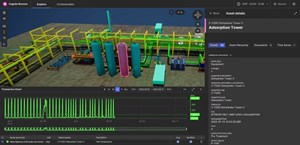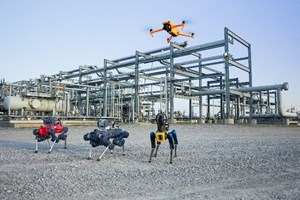Embracing and integrating the advantages of today’s robotic revolution
As we stand on the brink of a new era in the energy industry, the adoption and integration of robotics has become a leading topic in our discourse. This transformation, while still in its early stages, promises to revolutionize how we manage safety, productivity, and data within our operations—going as far as enabling the coveted state of remote operations.
Robots are becoming an integral part of our industry, taking on a variety of roles ranging from optimizing resources to improving operational safety. In fact, they’re already lauded in many areas for providing solutions that are not only more efficient but safer and more cost-effective.
Robots can, for example, take on recurring tasks such as routine inspections. The repeatability of such tasks improves tremendously when robots can collect data based on a predetermined mission. They perform the tasks consistently, while their actions and measurements are both timestamped and quantified for record and analysis (especially useful data when contextualized accordingly). Trend analysis sensitivity simultaneously improves, allowing for better predictive models with digital twins. Meanwhile, human operators and engineers can focus on more critical tasks, thereby leading to better resource allocation and efficiency.
The benefits of robotics are undeniable, and it’s only a matter of time before the energy industry catches up with others in adopting it.
Similarly, robots can also play a pivotal role in filling existing data gaps. By collecting more relevant data and synchronizing it based on event or time, robotics can provide you with a better understanding of your equipment or facility’s overall health. This ability to contextualize collected data leads to more informed decision-making, contributing to operational efficiency and safety.

One of the most significant advantages of robotics, however, is its contribution to increasing equipment uptime. By collecting data more frequently without any major increase in capital costs, you can shift from reactive and proactive maintenance to predicting equipment runtime based on the asset’s real-time conditions. This shift can reduce equipment downtime, potentially preventing the partial or total shutdown of production facilities and saving the associated costs. By monitoring the equipment's health in near real-time, issues can be detected in advance, remaining lifetimes can be forecast with more confidence, and equipment uptime can be maximized. And believe us when we say that based on ongoing trials, the results are promising.
Improving operational safety is another compelling argument for introducing robotics into our industry. Robots can be deployed in potentially hazardous situations, reducing the exposure of human operators. In case of gas leaks, for example, robots can be deployed to evaluate the situation before sending personnel to the area of concern—an invaluable capability in an industry where safety is paramount.
The current state of robotics adoption. Applying robotics contributes to increased efficiency, safety, and productivity, all of which are key goals for the sector. Despite its advantages, however, the adoption of robotics technology in the energy industry is still in its early stages. While robots are widely used in other industries, their use in the energy industry is not as widespread yet.
It's only a matter of time before robotics becomes quite pervasive in our sector, as well. The tech’s successful adoption simply requires that it gains people’s trust. Trust is built through the collection and sharing of real field data demonstrating robot safety and effectiveness. The more deployments that occur within the industry, the faster the adoption will be until it becomes commonplace.

That said, the adoption of robotics is not without its challenges, one of the main ones being the need to truly understand the capabilities and limitations of robots—both as a collective and based on specific vendors. Briefing all onsite personnel about how the robot(s) work is essential for the tech’s success. Furthermore, more employees should be involved in deployment exercises with both partners and vendors to better understand how to scale robot usage.
Another challenge is the need for standard work instructions and guidelines for robotics safety. There are some guidelines dating back to the 1980s, but we as an industry must now come together and create more modernized frameworks that accurately reflect the robotic evolution of recent decades. With an industry-wide effort to create these new standards and ongoing tech advancements, all adoption challenges can be overcome. Bonus: The next 3-5 years are expected to see more enhanced robots brought to market, thereby accelerating the adoption process.
Key considerations for seamless integration. When designing or retrofitting facilities to accommodate robots, there are several elements to consider:
- How to optimize the facility design to best utilize robotic capabilities
- The physical capabilities of robots
- Personnel safety.
First, the design of future facilities can be adapted to reduce overall capital expenditure (capex). This includes resizing certain elements to be smaller and lighter, reducing space needs, and even eliminating certain amenities on location (especially in offshore facilities). There might also be a reduced need for certain types of instrumentation, as some data collection tasks start to be performed by robots.
Many of today's facilities, however, are not ready for robots. In these cases, on-location adjustments may be necessary to ensure adequate navigation around the site given a robot’s physical limitations. Another consideration is where the robot will charge and its housing unit when it's not in operation, especially under different weather conditions.
Understanding the challenges of robotics is as important as understanding its promises.
Safety issues are yet another important consideration. As mentioned earlier, personnel safety can be improved if everyone working in a facility is briefed on how robots operate, their capabilities, and their limitations. For example, most robots have built-in safety features to avoid collisions, but some may not be able to detect certain body parts. They might not see a foot, but they will see a knee. Another example would be the different modes of operating robots have in onshore facilities versus offshore ones that mainly use grating surfaces.
While the journey to fully autonomous robotics within the energy industry is still in its early stages, the potential benefits are significant. The adoption of robotics promises to bring about increased efficiency, improved safety, and cost savings, propelling the energy industry into a new era of innovation and growth.
AUTHORS
Kiona Y. Meade -Digital business owner
Kiona Y. Meade is responsible for developing digital solutions that enable safer, optimized, and more sustainable production. Kiona’s two primary career ambitions are to contribute to the energy transition and improve diversity, equity, and inclusion within the industry across the world.
Nasser Ghorbani- Production subject matter expert
Nasser Ghorbani is a production subject matter expert at SLB. Prior to this role, he was an NPD digital lead for asset integrity where he led robotic tech development. He has developed many technologies from different TRL in nanotechnologies, automation, water analysis, MEG, gas processing, IIoT, digital, and robotics.
Eddie Gutierrez- Robotics product champion
Eddie Gutierrez is the robotics product champion at SLB. His previous experience includes working with robotics for inspection and asset integrity across the oil and gas, power generation, aerospace, military, pharmaceutical, and food and beverage industries. Throughout his career, he’s held various roles at the likes of Nexxis, Waygate Technologies, and GE Oil & Gas.
This article was originally published by SLB. To view, click here.


